- 2000 France
Les Saisons de la DANSE
"JAPAN OF ABUNDANCE - A symbol of the third generation / Juju Alishina"
A diminutive, strong-minded woman, Juju Alishina is one of the most striking representatives of the so-called third generation of Japanese dance. -------
While her work is based on the Oriental character of her dance, still her style is open-minded and keeps a strong international touch. Married to a Frenchman, she travels throughout the world, and has performed in Japan as well as in Europe or United States. Her last play,la main gauche - Laughing Fist - displayed in the Extrême-Orient festival, is a recreation of a work conceived during a stay in Israel. In this solo, she adopts the many faces of feminity, from the shy virgin to the abdicating empress. Working on feminity and feminism, she brings face to face her personality with the violence society may inflict on her : loss of identity, sadism, rape ... By a resrarch of what hands and face can express - sometimes exhibited, sometimes hidden - she attempts to render evident the two masks which structure our identity - the social one and the intimate one. Playing with various colours of music, she delivers a dance made of contracts, depicting all the diversity of her Self---.
- 2002 France
ELLE "Fascinante,
la danse japonaise"
- 2003 France
Votre Beauté-October
2003 "BUTO-express yourself"
Control of the body, importance of breathing,
undulations and improvisations
All converge in the externalization of emotion in positions revisited
by
contemporary choreography. For Butoh is a dance of the 20th century appearing
in Japan in the sixties, in reaction to ancestral Japanese art and steeped
in contemporary Western dance.
An art in rebellion against the past
Butoh first took on contemporary topics controversial for Japan: war,
violence.
Japanese choreographers sought to express the entire palette of human
emotions by gestures breaking with the ritualized forms of traditional
Japanese dance.
Butoh nourished itself from the European avant-garde and evokes contemporary
dance. Violence, eroticism, tenderness, fear, pain--all emotions are depicted,
in slow movements or tense postures.
The dancer may bare the claws of a cat or roll on the floor in choreographies
alternately peaceful or aggravated.
Each dance company reinvents its vocabulary of gestures and positions.
Juju Alishina, trained in traditional Japanese
dance, teaches Butoh in France in classes open to the public. She founded
her own company, Nuba
.THE BENEFITS
"The strangeness of the postures, which the body would never execute
in everyday life, endows the practice with a very exotic dimension,"
according to the young women who take the class. "The positions develop
the imagination, free pent-up feelings, require us to live our sensations
fully. Afterwards one feels free, light, one inhabits one's body."
"There is certainly a release of pent-up energy, but in controlled
movements," tempers Juju Alishina. "They
are good for the back because they are made up of many stretches,"
she emphasizes.
"Their goal is to circulate energy, and breathing is always controlled."
written by Jacqueline Tarliel (translated by Nancy Ohlenbusch)
2004 France TRIBUNE-October 12th "The invitation Japanese dance on the ponote scene"
On Thursday at 19h30 the Pierre-Cardinal theatre center proposes its first event of this season with the arrival on the ponotes scene of the Company NUBA and its choreographic representation of “L’épée de Chevet (Sleeping with a sword)".
The representation is an unexpected occasion to discover Butoh, a dance expression born in Japan in the 1960’s. Butoh is an avant-gardist dance which disturbed the the aesthetic and conservative ideas of Japanese traditional art. It celebrates the rituals of life through theatrical choreography. The Company NUBA created -----and her 2003 creation “L’épée de chevet (Sleeping with a sword)” is the opportunity to discover the rich mixture of Japanese and European dancers.
On Thursday evening they will be four to communicate in a corporal language the story of a heroine (warrior) abandon and left for dead in the heart of a cave. A rendezvous such as this with a new and accessible dance expression, oozing with serenity and depth is not to be missed under any circumstances.2004 France TRIBUNE-October 16th 2004
"Butoh dance according to Alishina: between traditional and contemporary"
Juju Alishina, dancer, choreographer and founder of the Company NUBA, presented on Thursday evening her last Butoh dance creation, “L’épée de chevet (Sleeping with a sword)”, to the Pierre-Cardinal center: a successful marriage of Japanese traditional dance and contemporary choreogaphy.
The Puy-en-Velay Theatre first cultural event of the season was a full house on Thursday evening at the Pierre-Cardinal center.
The event singled itself out as being particularly original and a rare occasion to discover, on the ponote scene the Japanese tradition art expression of Butoh dance reviewed and revised by Juju Alishina the renowned choreographer, revered and considered in the Land of the Rising Sun as a major personality in the third generation Butoh movement. Her style is appreciated and known as “A fine mixture of classical and avant-garde dance”---
---and as an innovation outlet in Butoh dance. Her notoriety extends internationally, and in 1998 she chose to relocate and to settle down in the Paris regional area, surrounding herself with contemporary European dancers. In the course of her creations emerges her assertive new artistic style which is a mixture of refined Japanese choreography, deeply dramatic and symbolic with the influences of Western contemporary dance.
The show “L’épée de chevet (Sleeping with a sword)”, created in 2003, and presented the night before last in Puy, is the depiction of a herione (warrior) abandoned and left for dead in the heart of a cave. The enigmatic character, wounded, determined and sensual is interpreted by Juju Alishna. Her movements are sometimes jerky, sharp and stiff, sometimes soft and fluid, expressing to her very fingertip the dramatized ritual: voilence, eroticism, pain, fear, the representation of all emotional states. Influence by the amazing music of Frédéric Thérisod, the heroine is lead into feverish hallucinations, and encounters a mysterious masked chalk face being, gesculating with movements also symbolic, but alot more contemporary.
A wonderful show, the concept is more or less accessible, but deinitively aesthetic and moving. L.V.2004 France EVEILOctober 17th“Cultural season: Oh yes, dance now!”
With about 180 spectators, the Cardinal center auditorium was nearly packed on Thursday evening during the representation of “L’épée de chevet (Sleeping with a sword)”.
The performance by the Company NUBA was dedicated to Butoh, an avant-garde dance born in Japan. The work of Juju Alishina, the Artistic Director of the company based in Paris,------- and this is exactly what caught the attention of this seasons public, especially that of the students of both the Charles-et-Adrien-Dupuy and the Saint-Joseph secondary school (high school).
In “Lépée de chevet (Sleeping with a sword)”, the decoration is reduced to the expression of simple stage lightings that tracks down the dancers every movement. The dancers refuses stale postures, body movements, and pantomime, while same time pulling together the subtle mixture in a theatrical way, the story of a heroine (warrior) abandon and left for dead in the heart of a cave---
This representation is a beautiful occasion for the novice to discover certain aspects of Japanese culture. Especially since Juju Alishina’s is internationally renowned: giving numerious performances in Japan, the United States, and in Europe, where she is considered as a major personality in the third generation Butoh movement.
2004 France MONTAGNEOctober 12th“Theater / Exploring the depths of Japanese Butoh”
A few just days from this season’s first performance, scheduled for Thursday evening, Jacky Rocher, Director of the theatre, is rather satisfied by the manner in which the events are---
A dance full of depth and tranquillity, a bit ascetic and almost mystic
The opening night is scheduled for October 14, and will plunge the audience into the world of Butoh.------------ "For a very long time I have wanted to organize a Butoh event, but the performances are usually technally very complicated. Today it is a dance full of tranquillity and depth, a bit ascetic and almost mystic" The ponote public will discover the world of Butoh with “L’épée de chevet (Sleeping with a sword)”, a Company NUBA creation. Attention, do not think that it is folklorish.The heroine fatally injured tries to free herself from the cave in which she is trapped and left for dead.Like in many contemporary representations the story is only a pretext designed to lead the spectator into the mind of the heroine, who struggles with her inner demons, taking you on a voyage into the spiritual realm. Butoh is also a very important representation of the fine combination of corpal expressions, aestheticism and music---.
2005 New Caledonia / Les Nouvelles Calédoniennes/ Weekend sorties "Performances from six countries at the Tjibaou Center"
-- Particular attention will be given to "Absence" a performance of Japanese dance between extreme slowness and sudden gestures.
2005 August 24, France / ZURBAN "Cours Toujours"
--- For ages, Japanese traditional dance has ferociously held on to its secrets, but in the era of globalization, all you need to do today in order to be initiated into the movements of the butô, and its aesthetics and its philosophy is buy a metro ticket and enroll in Juju Alishina's classes. From walking to undulation, from improvisation the work of the face or voice, this is where you will again find the occasion to plunge in depth into the world of the Rising Sun.
By Gwendoline Raisson
2005 Décembre New Caledonia / Les Nouvelles Calédoniennes / Week-end sorties "Japanese dance for the last performance of the season"
To close the 2005 season, the ADCK proposes a creation of a renowned Japanese choreographer, Juju Alishina. Halfway between Butoh and contemporary dance, "Absence" depicts the range of feelings through the story of a princess held prisoner.-----
2005 Décembre New Caledonia / Les Infos/ Geste Station
The last performance of the year, "Absence," the new creation of the Japanese Company Nuba amazed the audience of the Sisia performance space (Theater of Tjibaou Center) with its choreographic and theatrical originality). Strong presences...
The Butoh is a determinedly modern dance, appeared in Japan forty years ago. It was influenced by the Occidental contemporary dance, as for the choreography as for the approached subjects. - - -
In the face of tradition
The dancer(Juju Alishina), at first crawling, assumes postures in which the position of the hands, feet, and fingers takes on great importance, as often in Asia. - - -
- - -two solitudes join together after having for a long time been unaware of each other. Fusion of chalky bodies in staccato and sometimes fluid aesthetic postures, always with gestural perfection. Death of the woman, arrived from the other one, game of the life mimed as a part of ball-playing and a divine punishment.
The empire of senses, danced so well it unsettled the public. Original, curious and dazzling to the last bow, this evening was all this. Were absentees wrong or reason? To see anyway...
Written by Nippolross
2005 December New Caledonia / Tele 7 jours "Nuba's Butoh
Dance: Absence"
The company Nuba will occupy the Tjibaou cultural centre for three performances of Absence on December 8 , 9 , 10. A divinely aesthetic performance of Butoh dance, to become immersed in a destabilizing Japanese culture in full transformation.
This dance appeared in Japan in the 1960's, the Butoh was necessary quite in force in front of a Japanese ancestral art with which it enters rebellion. Inspired by the Occidental modern dance, it restores marvelously violence, eroticism and pain of feelings, supported alternately by slow movements or aggravated postures. Learning the traditional dance and the Butoh, Juju Alishina is one of the most remarkable ambassadresses of this symbolic, imaginative and mysterious Japanese art. - - -
Aesthetic and Mystical
Full of peace and depth, slightly ascetic and almost mystical, the work of Juju Alishina finds its sources today in Paris, where it has been based since 1998. And at the heart of Absence - her new creation in two parts-, a soloist traces first the solitude of a princess long ago held prisoner, whom she interprets. Then comes the moment of the duet with the talented and sculptural Ippei Hosaka – a young hope of the company- to embody with a score for two bodies the violence and madness of the season of courtship. Carried by sharp then smooth movements, dramatized then interiorized, you can bet that this magnificent performance, divinely aesthetic and unsettling, will touch the heart of New Caledonian fans.
Written by Sophie Tiphagne
2006 France / <Tendances Butô > Journal "Butoh for the first time in New Caledonia : ABSENCE, a choreography by Juju Alishina with Dance Company NUBA"
In the middle of winter, a cold December, it’s like summer in New Caledonia, the fragrance of flowers…
-
ABSENCE has already played in Paris and the choreography was adapted to Tjibaou's stage. More dynamic gestures and movements corresponded to the artistic choices of Juju Alishina.
It is the story of a prisoner, a woman dying of torture.
The 1st part is a solo by this woman ( Juju Alishina), the 2nd is a duet with a male dancer (Ippei Hosaka).
This man is the woman’s illusion : he does not exist.
She is the ghost of a prisoner : she does not exist.
No one exists on the stage.
Absence.
When one thinks about daily life.
Everywhere, a computer environment.
We do not know reality.
Absence makes a person all the more present.
" In 2004, When I was preparing ABSENCE, my mother was at the end of her life in Japan. My family and I always had this distance since 1983. I had become a professional dancer and I lived in Tokyo. I went to visit them in Kobe, once a year.
Since 1998, another distance, from France to Japan.
I would like to redefine the notion of distance, we could say that " death " is the changing of distance from France to Japan, between the earth and the heaven. "
Themes touched upon in the performance: distance, identity, reality, fiction, virtuality
-
epilogue
" we perform the same choreography, but never the same show.
To perform abroad is to export one’s body. Today, everything can be copied and amplified but the body remains unique, that’s why physical art is exceptional . "
Written by Christine Taniga from Juju Alishina's text
2006 January France / < Juste Debout >– the magazine of other dances A dance with history: Butoh
Butoh: an art in rebellion with the pastButoh dance has built itself upon a history of oppositions. " Dance of darkness " and white-painted bodies. Japan races economically but the movements of this dance are very slow.
It rejects Occidental culture yet is profoundly inspired by German expressionism and European literature. The painful birth of a dance for the 20th century - - - Marginalized in their country, Butoh dancers in the 70s came to look for recognition in Europe. They found their public in France, on the occasion of the Nancy Festival in 1971, the Autumn festival in 1978, and at the Théâtre de la Ville in Paris.
Today Carlotta Ikeda, Amagatsu and his company Sankai Juku, Eiko and Koma, Tomiko Takai, Juju Alishina and her company Nuba carry the torch of Butoh.
Butoh
A " butôlique " atmosphere
How can we perceive a culture when we do not come from it? The < Just Debout > Magazine investigated this question in a Japanese Butoh class more than 9700 km from its place of origin, at the Centre du Marais in Paris. The « butôlique » of a dance class not like the others, where one comes out more rested than when one came in.
This evening, it is Delphine Brual, a dancer in the Nuba company and Juju Alishina's assistant, who is giving the class, and it really is a gift.
- - - - -
written by Shèyen
2006 France / <Bito> Web-magazine "Juju Alishina, the power of the physical expression"
A slender silhouette, long black hair, a pleasant smile and a shy stalk. In spite of the fragile appearance, almost evanescent, Juju Alishina, dancer and choreographer, captivates glances. In the life, this Kobé's native is a wife and a mother as the others. On the stage, motionless lines, sheembodies an almost mystic feminine figure.
10:50am, one on Saturday morning in the gym of Lilas. I return in steps felted in the studio dance. I am late. the pupils are already following Juju Alishina's instructions, director of the company of dance NUBA, created in 1990.
They are all « former » they participate in the classes of BUTOH (choreographic Japanese art was born in the sixties in break with the aesthetic codes of the Japanese ancestral art) for one year or new minimum month. The atmosphere is almost collected. Breathing, stretching, softenings. In the beginning, that looks like the gym.
Then, after this series of exercises, Juju invites everybody to work a subject. Today, she chose the mermaid. Tight legs and feet crossed to imitate the tail of fishes, the bodies evolve, become muddled, dance some with the others, in a sort of synchronized swimming. Some laughter fuse here and there. Two by two, then all together, the participants wave and contort, crowd and touch, evolving so-so deprived of the usage of their legs, straight from the ground.
One pantomime of the life Improvisation, representation and imitation of an element of the nature, the animal or the human being. All the essence of the work of Juju is there. The approach of the Butoh is little conventional. It is at the same moment a discipline of the body and a strong liberation of feelings, a mix of contemporary elements and Japanese tradition.
" She teaches us especially to find our own dance. She gives us tracks to be investigated with our body and our feelings. Then it is for us to make our way. " One of her pupils Catherine confides.
In Juju Alishina's art, the body stages in a dramatic way, as in a representation of Kabuki ( Japanese theatrical technique). Every posture, purified, is charged with a powerful suggestive power; love, death, dismay, cruelty. Are read in every attitude, are incarnated in the body of the dancer in the light.
The costume and the music of the performance are the inspiration of the artist. Juju Alishina attaches a big importance to the musical subject which accompanies the dance. Certainly, it can seem logical for a choreographer to base its work partially on the music, but for Juju Alishina, it is also a means to make atypical and audacious choices. " I worked as well with Japanese musicians as with Occidental musicians. I danced for example on the creations of a Spanish musician " she clarifies. Among the musicians who inspired her, Juju Alishina quotes gladly very classic Olivier Messiaen, or still Frédéric Thérisod (of Kaï Trio) her husband. To see her working is a fascinating experiment as she leaves an important part of the creation for the improvisation. " Even I prepare certain movements, she admits, improvised passages come after prepared passages alternately " .
Dancer every inch
This brimming imagination, this greediness for new experiments and this opening characterize the artistic personality of Juju Alishina.
In rehearsal, she evolves under the attentive glance of Catherine and accepts gladly suggestions and remarks of her pupil. " I often call Catherine, I explain her, because it is important to have an opinion or an impression on the sequences and movements which come to me in the spirit ".
She notes scrupulously her ideas on a pad or on sheets; drawings minimalists of silhouettes who cross squares representing the scenic space.
And so she works flow and harmony of the movements, and invents an enigmatic body movements, sometimes supple, sometimes jerky.
Juju Alishina solo in "Tout l’or du ciel". / its next spectacle, - a creation in three parts (Sea, Earth and Sky) which she will present on June 16 and 17 to the cultural space Bertin Poirée within the 7th Butoh Festival. Juju Alishina planned to dance solo on scene: " for two years, I did not play a solo. It is testing and very practical at the same time to prepare performance alone ". Once again, it was inspired by Messiaen's music - " Haiku " and " Garden of the sleep of love " - which harmonizes so well with the mimes the baroque.
Since she began the career in 1982, Juju Alishina has respite to reinvent the Japanese dance of which it is today one of the best ambassadresses, in France where she lives since 1998, as all over the world. Formerly on roads to quench the passion, Juju Alishina recognizes today to have the other priorities: " I didn’t go many tours these years. I had to take care of my family " she smiled.
written by Françoise Diboussi
2006 August France / <Santé> magazine "Zen, the Butoh"
The Butoh has many different qualities. the Butoh is for Antistress and relaxation, the Butoh is a discipline phisique as so intellectual, halfway enter art martiel and contemporary dance.
Born in Japan in the 60s and influenced by European avant-gardes, this " dance of darkness " at first attacked big taboos: violence, eroticism, death. The Japanese choreographers tried to express all the palette of feelings: bodies painted in white, slow movements, distorted and deformed postures which aim to connect conscious and unconscious, outside and the inside.
Today, the classes of Butoh every public propose a serene version, a source of prosperity rather than exorcisme. - A means to investigate all the facets of the being through the body, the feelings and to prop up the internal rhythm in accordance with the cycles of the life.
Trump cards shape
Control of the body, Breathing, master the gesture, learning of the release , codified chains of movements and improvisations, in duet or solo.
It’s a more than a dance, a real therapy! There are many profits on the physical plan: excellent for the back, the Butoh seeks all the deep muscles, develops flexibility and coordination while favoring a perfect oxygenation. Ideal to re-harmonize energies and to feel as well in our body as in the head.
Where to learn
Company NUBA, directed by the Japanese choreographer Juju Alishina, at the Centre de Danse du Marais and at the Gymnase des Lilas.2008 Octobre Italie / <FLAÏR> magazine "GOTICO"
Gothic
Evocative atposphere for an unknown encounter between
Fashion and the poetic choreography of Danse Company NUBA
2008 June France / <News Digest > News Paper "to learn the Butoh dance in Paris"
2009 June France / <BISOU> News Paper
"Release and discover yourself through this dance "
TOP PAGE
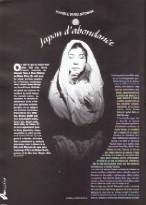
Magazine"Les Saisons de la Danse"2000 photo: Makoto Horiuchi
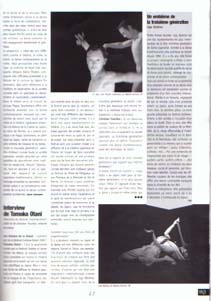
Magazine"Les Saisons de la Danse"2000 photo: Makoto Horiuchi
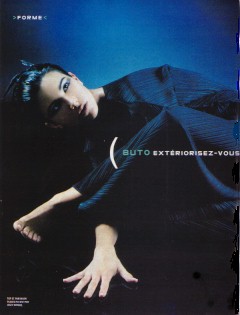
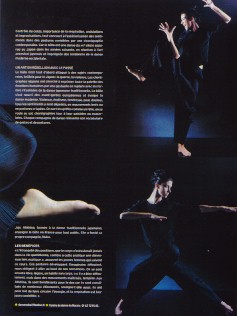
Magazine "Votre Beauté" october 2003
dancer : MICHEL, photo : ELIAS, costumes : Miyake Issey, Choreograph : Juju Alishina
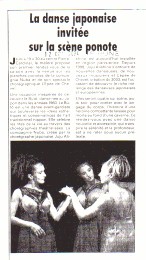
Newspaper
"TRIBUNE"-October 12th 2004
dancers : Delphine Brual,Morgane
Dragon,Peggy Gilardi,
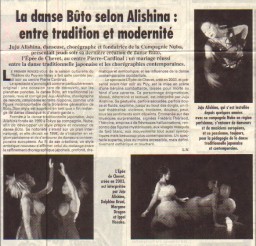
Newspaper "TRIBUNE"-October 16th 2004
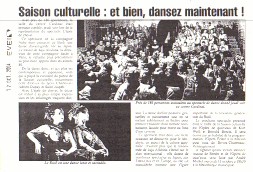
Newspaper
"EVEIL"-October
17th 2004
dancers : Delphine Brual,Morgane
Dragon,
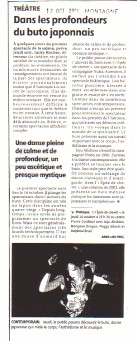
Newspaper
"MONTAGNE" - October
12th
dancer : Juju Alishina
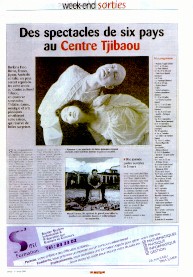
News paper "Les Nouvelles
Calédoniennes/week-end sorties
(New Caledonia)"Feb. 26th 2005
dancers : Juju Alishina, Hosaka
Ippei
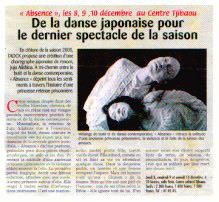
News paper "Les Nouvelles Calédoniennes / week-end sorties" 3/12/2005
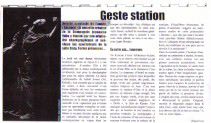
Newspaper
"Les Infos/Geste stations"(New
Caledonia) December
2005
dancer
: Juju Alishina
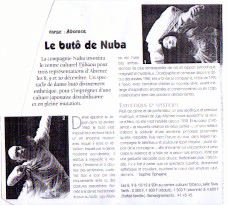
magazine "Télé 7 jours"(New Caledonia) December 2005
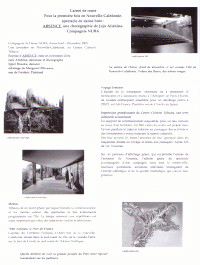
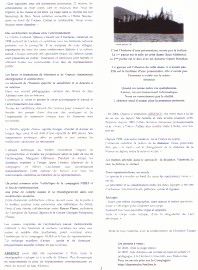
journal
"Tendances Butô"
2006
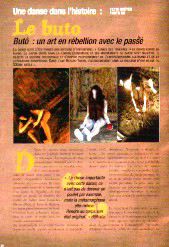
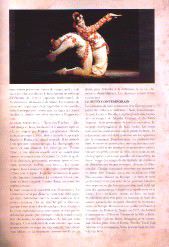
Magazine
"Juste
Debout " january 2005 dancers
: Delphine Brual,Peggy Gilardi
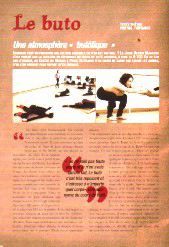
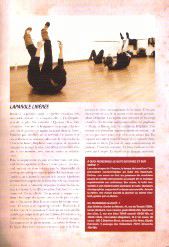
Magazine "Juste Debout " january 2005
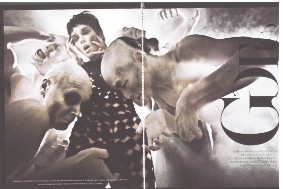
©Magazine FLAIR oct.2008
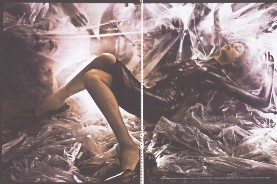
©Magazine FLAIR oct.2008
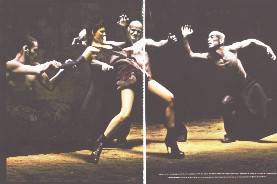
©Magazine FLAIR oct.2008
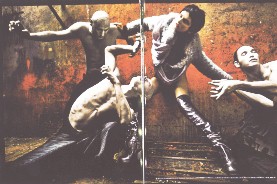
©Magazine FLAIR oct.2008
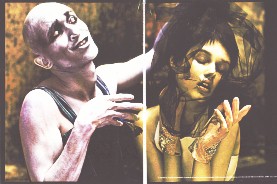
©Magazine FLAIR oct.2008
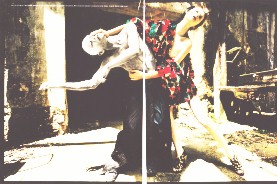
©Magazine FLAIR oct.2008
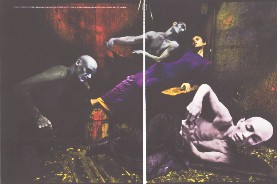
©Magazine
FLAIR oct.2008, photo : Jean-François Campos choreography :Juju
Alishina
Dancers : Ippei Hosaka, Laurent Bur, Miki
Tajima, Nelson Ferreira, Model : Giedre Dukauskaite
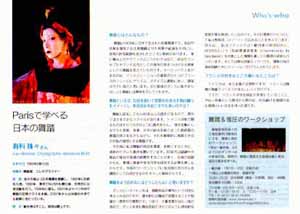
News paper "News Digest" -Juin 2008
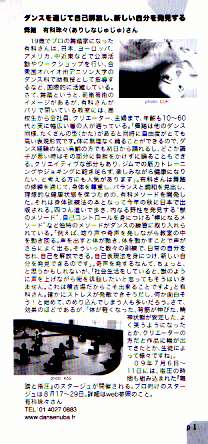
News paper "Bisou" -Juin 2009